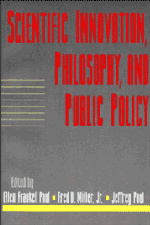Book contents
- Frontmatter
- Contents
- Introduction
- Acknowledgments
- Contributors
- The Human Genome Project: Research Tactics and Economic Strategies
- Choosing Who Will Be Disabled: Genetic Intervention and the Morality of Inclusion
- Germ-Line Genetic Engineering and Moral Diversity: Moral Controversies in a Post-Christian World
- Self-Critical Federal Science? The Ethics Experiment within the U.S. Human Genome Project
- When Politics Drives Science: Lysenko, Gore, and U.S. Biotechnology Policy
- Biotechnology and the Utilitarian Argument for Patents
- Property Rights Theory and the Commons: The Case of Scientific Research
- Property Rights and Technological Innovation
- Medicine, Animal Experimentation, and the Moral Problem of Unfortunate Humans
- A World of Strong Privacy: Promises and Perils of Encryption
- Computer Reliability and Public Policy: Limits of Knowledge of Computer-Based Systems
- Responsibility and Decision Making in the Era of Neural Networks
- Preposterism and Its Consequences
- Index
When Politics Drives Science: Lysenko, Gore, and U.S. Biotechnology Policy
Published online by Cambridge University Press: 04 August 2010
- Frontmatter
- Contents
- Introduction
- Acknowledgments
- Contributors
- The Human Genome Project: Research Tactics and Economic Strategies
- Choosing Who Will Be Disabled: Genetic Intervention and the Morality of Inclusion
- Germ-Line Genetic Engineering and Moral Diversity: Moral Controversies in a Post-Christian World
- Self-Critical Federal Science? The Ethics Experiment within the U.S. Human Genome Project
- When Politics Drives Science: Lysenko, Gore, and U.S. Biotechnology Policy
- Biotechnology and the Utilitarian Argument for Patents
- Property Rights Theory and the Commons: The Case of Scientific Research
- Property Rights and Technological Innovation
- Medicine, Animal Experimentation, and the Moral Problem of Unfortunate Humans
- A World of Strong Privacy: Promises and Perils of Encryption
- Computer Reliability and Public Policy: Limits of Knowledge of Computer-Based Systems
- Responsibility and Decision Making in the Era of Neural Networks
- Preposterism and Its Consequences
- Index
Summary
It has been said that those who do not remember the past are condemned to repeat it. It is important, therefore, to consider the parallels between the decimation of basic and applied biology by Trofim Denisovich Lysenko in the Soviet Union earlier in this century and the battering of present-day biotechnology by the Clinton administration. In both cases, we see the sacrifice of new science to old myth; heterodox, unscientific theories steering public policy; the abject failure of that public policy, with dire outcomes for research and commerce; and glib, condescending, and exclusionary attitudes toward policymaking.
LYSENKO, OPPRESSOR OF SCIENCE — AND SCIENTISTS
Recall the case of Lysenko, the meagerly educated peasant agronomist and Soviet technocrat. In the decade following the collectivization of agriculture, which began in the late 1920s, the crisis in grain production had elicited in Soviet bureaucrats a yearning for a quick fix. Lysenko promised it, in the form of greater, more rapid, and less costly increases in crop yields than other scientists thought possible. As the incumbent in a series of posts and finally as director of the Institute of Genetics of the Academy of Sciences of the USSR and president of the then-powerful V.I. Lenin All-Union Academy of Agricultural Sciences, he challenged the dogma that genes conveyed hereditary traits, and despite the absence of experimental support, preached Lamarckian doctrine: that traits acquired by an organism during its lifetime could be passed on to its offspring.
- Type
- Chapter
- Information
- Scientific Innovation, Philosophy, and Public Policy , pp. 96 - 112Publisher: Cambridge University PressPrint publication year: 1996



